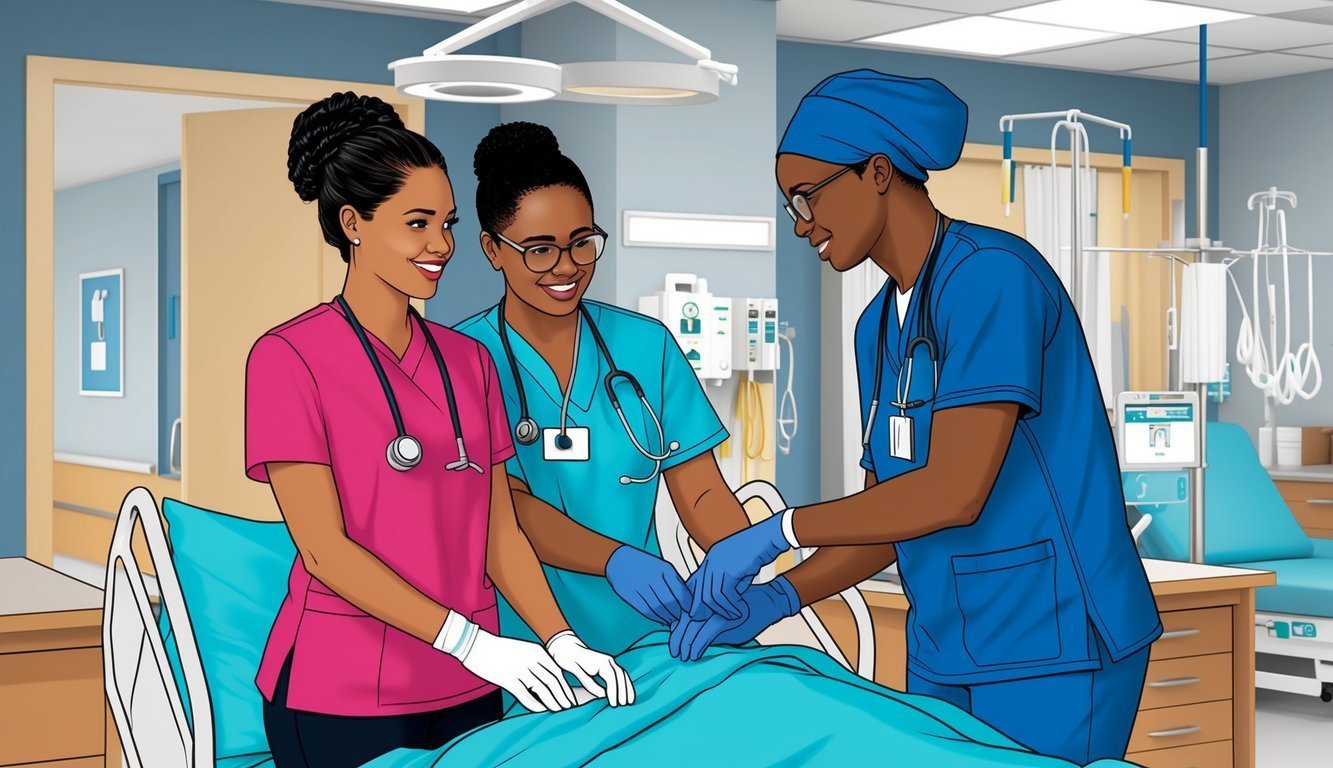Navigating the nursing field can be daunting, especially when trying to understand the differences between Licensed Practical Nurses (LPNs) and Registered Nurses (RNs).
LPNs often focus on basic patient care under the supervision of RNs or physicians, while RNs have a broader scope, allowing them to perform critical assessments and develop care plans.
As you delve deeper into the roles of LPNs and RNs, you’ll uncover essential differences in education, training, and day-to-day responsibilities.
This information is crucial if you’re considering a career in nursing or if you’re working with both types of professionals.
Gaining insight into their specific duties can help you better understand how they collaborate to deliver high-quality patient care, as well as the regulations that govern their practices.
To explore the nuances of LPN and RN roles, including examples of their respective scopes of practice, dive into detailed resources that clarify these distinctions, such as the information provided at Nurse.org and Goodwin University.
Understanding these differences will empower you to make informed decisions in your nursing career or in managing your healthcare needs.
Understanding Scope of Practice
The scope of practice defines the duties and responsibilities that nurses can undertake based on their licensure.
Understanding the specific roles of Licensed Practical Nurses (LPNs) and Registered Nurses (RNs) is essential for effective healthcare delivery.
Definitions and Differences
The scope of practice refers to the range of roles, functions, responsibilities, and activities that a nurse is permitted to perform in accordance with their licensure.
| Aspect | LPN | RN |
|---|---|---|
| Education | 1-year diploma | 18-24 month ADN or BSN program |
| Patient Assessment | Limited; cannot perform initial assessments | Comprehensive; performs initial assessments and complex care planning |
| Independence | Works under RNs or physicians | Can work independently in most settings |
RNs have a broader scope, allowing them to handle more complex tasks such as developing care plans and providing advanced patient assessments.
LPNs, in contrast, focus on basic patient care and support under supervision.
Nurse Practice Act
The Nurse Practice Act is a set of laws that govern nursing practice in each state.
It establishes the legal framework for nursing and defines the scope of practice for different nursing roles.
Each state’s act varies, outlining what is legally permissible for LPNs and RNs.
For example, the act delineates supervisory roles, educational requirements, and additional specialties that nurses must adhere to.
Understanding these regulations helps ensure that you practice within your legal boundaries, ultimately enhancing patient safety and care quality.
For detailed insights, refer to your state’s specific Nurse Practice Act, as it guides nursing conduct and responsibilities in healthcare settings.
Education and Licensure
Understanding the educational paths and licensure processes for LPNs and RNs is crucial for anyone considering a nursing career.
Each path requires specific training and exams that impact your future scope of practice.
LPN/LVN Education
To become a Licensed Practical Nurse (LPN) or Licensed Vocational Nurse (LVN), you typically need to complete a one-year accredited practical nursing program.
These programs focus on essential nursing skills, including patient care, basic medication administration, and vital signs monitoring.
Curriculum components often include:
- Anatomy and Physiology
- Nursing Fundamentals
- Pharmacology
In most states, completing an approved program is necessary before sitting for the NCLEX-PN exam, which tests your competencies as an LPN.
Practical nursing programs are generally available through community colleges, vocational schools, and online options, making them accessible for many students.
RN Education
Becoming a Registered Nurse (RN) requires a higher education level, typically an Associate Degree in Nursing (ADN) or a Bachelor of Science in Nursing (BSN).
ADN programs usually take two to three years, while BSN programs require about four years.
Key coursework may include:
- Advanced Health Assessment
- Leadership and Management
- Nursing Research
Upon completion, graduates are eligible to take the NCLEX-RN exam.
RNs have a broader scope of practice, involving more complex patient care, which is vital for those looking to advance in the nursing field.
Various nursing programs are available, and you can find accredited options through institutions such as the American Association of Colleges of Nursing.
Licensure Exams
Licensure is a crucial step for both LPNs and RNs to practice legally.
After finishing your educational program, you’ll need to pass a specific exam to obtain your license.
For LPNs, the NCLEX-PN exam assesses foundational nursing knowledge.
Preparing through review courses can enhance your chance of passing.
RNs must pass the NCLEX-RN exam.
This exam includes questions on nursing processes, health promotion, and physiological integrity.
Preparation can involve study groups and practice tests.
Successful completion of these exams allows you to receive your licensure, enabling you to begin your nursing career.
Consider utilizing resources like nursing forums and study materials to further support your exam preparations.
Roles and Responsibilities
Understanding the specific duties and responsibilities of LPNs and RNs is essential for those considering a nursing career.
Each role has distinct functions that contribute to patient care and the overall healthcare team.
LPN Duties
Licensed Practical Nurses (LPNs) play a crucial role in patient care under the supervision of RNs or doctors.
Their responsibilities include:
- Vital Signs Monitoring: LPNs are trained to monitor and record patients’ vital signs such as blood pressure, heart rate, and temperature.
- Wound Care: You will be responsible for cleaning and dressing wounds, ensuring that the healing process is managed effectively.
- Medication Administration: LPNs can administer medications as prescribed, following specific guidelines and protocols.
- Basic Patient Care: This includes assisting with daily activities like bathing, dressing, and mobility.
- Nursing Care Plans: LPNs help to implement nursing care plans and may participate in updating these plans after assessing patients’ ongoing needs.
These duties require strong clinical skills and a solid understanding of patient care.
RN Duties
Registered Nurses (RNs) have a broader scope of practice and significantly more responsibilities.
Key duties include:
- Initial Assessment: You will perform the first patient assessments, evaluating complex health conditions that LPNs may not manage.
- Develop and Manage Nursing Care Plans: RNs create and oversee comprehensive nursing care plans based on patient assessments.
- Supervising LPNs: An essential role involves supervising LPNs and ensuring they follow proper protocols.
- Complex Medical Procedures: RNs initiate and monitor treatments, including administering blood products and intravenous therapies.
- Patient Education: You will educate patients and families about health conditions, treatment options, and medication management.
The responsibilities of RNs are critical in ensuring high-quality nursing care across diverse healthcare settings.
For more insights, you can explore details on LPN vs RN differences or LPN role specifics at Nurse.org.
Working Environment

The working environment for LPNs and RNs varies significantly based on the healthcare setting.
Understanding these environments can help you evaluate which role aligns with your career goals.
Healthcare Facilities
In hospitals and nursing homes, the working environment for both LPNs and RNs is dynamic and fast-paced.
Hospitals typically require RNs to lead patient care, while LPNs support with basic nursing tasks and patient monitoring.
| Facility Type | LPN Role | RN Role |
|---|---|---|
| Hospitals | Assist in patient care | Conduct assessments and lead care |
| Nursing Homes | Provide daily patient care | Manage health plans and evaluate care |
| Skilled Nursing Facilities | Support recovery and rehabilitation | Oversee complex medical needs |
RNs often work independently, whereas LPNs collaborate closely with RNs and other healthcare professionals.
Both must adapt to their specific facility’s policies and procedures.
Specialized Care Settings
In specialized care settings such as rehabilitation facilities and home healthcare, the responsibilities differ further.
RNs often take on more complex patient needs, particularly in rehabilitation where assessments and treatment plans are crucial.
LPNs in these environments typically focus on day-to-day tasks like medication administration and monitoring vital signs.
- Rehabilitation Facilities:
- LPNs assist with daily therapy routines.
- RNs manage patient admissions and develop rehabilitation plans.
- Home Healthcare:
- LPNs deliver in-home nursing care.
- RNs provide assessments and create care strategies.
Understanding these environments highlights how different roles interact and contribute to patient care across various healthcare facilities.
Career Trajectory and Advancement
In nursing, career advancement varies significantly between licensed practical nurses (LPNs) and registered nurses (RNs).
Understanding the pathways available and the importance of continuing education can greatly influence your professional growth and earning potential.
Advancement Opportunities
As an LPN, your career advancement prospects are somewhat limited compared to RNs.
The scope of practice for RNs is much broader, allowing them to take on roles with greater responsibility.
Many LPNs transition to RN positions through LPN-to-RN programs.
These programs can lead to obtaining an Associate Degree in Nursing (ADN) or a Bachelor of Science in Nursing (BSN).
The table below outlines potential career paths:
| Position | Education Required | Average Salary (Annual) |
|---|---|---|
| LPN | 1-year diploma | $48,000 |
| RN (ADN) | 18-24 months | $86,070 |
| RN (BSN) | 4 years | $86,070+ |
With a BSN, you may access advanced roles, including nurse manager or educator, which offer not only higher salaries but also job stability.
Continuing Education
Continuing education is essential in nursing and can significantly impact your career advancement opportunities.
Engaging in ongoing training helps you stay current with best practices and clinical advancements.
Many states require RNs to engage in continuing education to maintain their nursing licenses.
Pursuing specialized certifications can also enhance your qualifications.
You can explore options such as:
- Certification in critical care
- Pediatric nursing
- Gerontology
By investing in your education, you increase your earning potential and open doors to higher positions within the nursing field.
The salary and career outlook for RNs is generally more favorable than for LPNs.
RNs also have the option to pursue master’s and doctoral degrees for advanced practice nursing roles.
Comparing Salaries and Job Outlook

When considering a career in nursing, understanding the salaries and job outlook for both LPNs and RNs is essential for making an informed decision about your future.
Each role offers distinct earning potential and market demand that can significantly influence your career trajectory.
LPN/LVN Salary and Job Market
The average salary for Licensed Practical Nurses (LPNs) varies based on factors like location and experience.
As of 2024, you can expect to earn around $56,000 per year.
The Bureau of Labor Statistics (BLS) projects a 5% employment increase for LPNs through 2032, which translates to more than 54,000 job openings each year.
| Salary Percentile | Annual Salary |
|---|---|
| Bottom 10% | $45,670 |
| Median | $60,790 |
| Top 10% | $77,870 |
LPNs are mainly employed in skilled nursing facilities, where salaries can reach $63,730 annually.
Your earning potential may increase with additional certifications or specialized training.
RN Salary and Job Market
Registered Nurses (RNs) generally command higher salaries due to their advanced education and wider scope of practice.
In 2024, the average salary for RNs is approximately $80,000 per year.
The demand for RNs is also strong, with a favorable job outlook reflected in a high number of annual job openings.
| Salary Percentile | Annual Salary |
|---|---|
| Bottom 10% | $60,000 |
| Median | $80,000 |
| Top 10% | $100,000+ |
Job opportunities for RNs are expected to grow significantly, driven by factors like an aging population and the increasing focus on healthcare services.
This growth opens the door to various specialties, enhancing your earning potential based on your career path.
For further details, visit Nurse Journal for insights into nursing roles and salaries.

